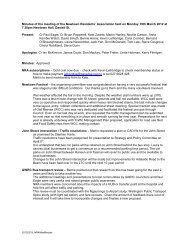Draft Town Belt Management Plan - Wellington City Council
Draft Town Belt Management Plan - Wellington City Council
Draft Town Belt Management Plan - Wellington City Council
You also want an ePaper? Increase the reach of your titles
YUMPU automatically turns print PDFs into web optimized ePapers that Google loves.
However, elite sport and associated events are important to <strong>Wellington</strong> as a destination for major<br />
events, entertainment, and also to provide a pathway for talented young people to develop their<br />
skills and develop a career in elite or professional sport. Such sport can sometimes bring in<br />
external funds to improve facilities that can in turn benefit community sport.<br />
6.4.2 Club facilities<br />
Tennis, bowling and croquet clubs have leased areas for specialised playing surfaces and/or<br />
clubrooms. Other clubs, such as rugby, cricket and athletics, lease land for clubrooms. In addition,<br />
some clubs lease facilities for indoor sport including badminton, squash, darts and more recently<br />
Harbour <strong>City</strong> Gym Sports at Hataitai Park.<br />
<strong>Wellington</strong> Scottish Athletic Club,<br />
Prince of Wales Park<br />
There are 39 clubs and community groups<br />
leasing a total of 5.9ha of land on the <strong>Town</strong><br />
<strong>Belt</strong>. Most of these facilities have buildings<br />
that are only available for club members.<br />
Some, such as bowling clubs and tennis, are<br />
available to be used on a pay-for-play<br />
(casual) basis. The location and number of<br />
clubs are shown in the map of recreation<br />
facilities for each sector (section 8). Many<br />
clubs sub lease facilities to other clubs to<br />
make best use of the facilities and share costs<br />
as well as allowing casual play.<br />
Leasing is permitted to enable the public use<br />
of the <strong>Town</strong> <strong>Belt</strong> by providing a wider range<br />
of facilities than would otherwise be<br />
available.<br />
Over the past 15 to 20 years, public opinion has shifted in favour of informal recreation and access<br />
to the entire <strong>Town</strong> <strong>Belt</strong>. At the same time there has been growth in some structured formal sports,<br />
such as football, which has put more pressure on existing formal facilities. The shift to informal<br />
recreation was reflected in the policies in the 1995 plan, which identified that activities on leased<br />
land should be open to public participation and that leases should not restrict public access across<br />
the land except during times of active use. In practical terms this is very difficult to achieve given<br />
several sports have indoor facilities, including the Renouf Tennis Centre and Badminton Hall; and<br />
specialist surfaces such as bowling and croquet greens should not be accessed except for actual play<br />
because of the possibility of damage.<br />
With the exception of sports such as football, many traditional sports clubs are experiencing<br />
declining membership. This issue has been further complicated by the rising cost of maintenance,<br />
building compliance and insurance. However, another influencing factor is the increase in casual<br />
sport (pay-for-play). Many people are choosing to participate in sport and recreation on a casual<br />
basis rather than committing to membership of a club. There is also more choice, and there have<br />
been a number of emerging sports such as floorball, handball, ultimate frisbee and futsal.<br />
The <strong>Council</strong> is working with a number of clubs (eg bowls) to address sustainability issues. Many<br />
clubs are being encouraged to amalgamate or to share resources/facilities. This is commonly<br />
referred to as a ‘sportsville’ model. Some clubs are investigating commercial<br />
activities/opportunities to enable them to raise funds. This varies from charging for play, or<br />
sponsorship, through to running commercial facilities such as cafés.<br />
6.4.3 The track network<br />
The notion of public access is integral to the intent of the original <strong>Town</strong> <strong>Belt</strong> Deed. The emphasis<br />
has always been on walking access and, since the 1990s, mountain bike access. Other activities<br />
include orienteering, dog walking, school cross-country and harriers.<br />
<strong>Draft</strong> <strong>Town</strong> <strong>Belt</strong> <strong>Management</strong> <strong>Plan</strong> October 2012 49





